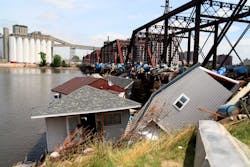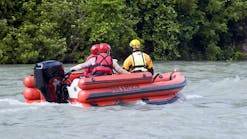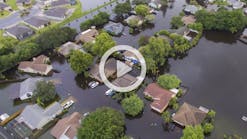The Iowa Flood of 2008 spanned June 8 to July 1. Encompassing much of the state’s eastern half, it caused $6 billion in property damages and an estimated $3 billion in agricultural losses. The Cedar River crested at 31.12 feet in Cedar Rapids — 19 feet above flood stage and 11 feet above the 1929 and 1951 records. The flood affected 1,300 city blocks, damaging 5,238 homes, 940 businesses, and 77 non-profits and faith organizations in the state’s second largest and hardest-hit city.
In 2009, the state created the Iowa Flood Center (IFC), an academic center focused on floods, representing state officials’ commitment to better understand and manage water resources.
“We took the tragedy of 2008 and created the flood center as the central component to say, ‘Never again,’” says Senator Rob Hogg, a four-term Cedar Rapids Democrat.
The unique center is now poised to play a prominent role in a national hydrology research cooperative.
Larry Weber, then director of IIHR–Hydroscience & Engineering (IIHR) at the University of Iowa, recalled his initial meeting with Hogg and other legislators in October 2008.
Hogg had said, “The reason we’re here is that we don’t want what happened this summer to ever happen again.”
Two months later, Weber received a request for a proposal to create an Iowa Flood Center. He teamed up with Witold Krajewski, the Rose & Joseph Summers Chair in Water Resources Engineering at the University of Iowa, to outline a description of the proposed entity and submitted it to lawmakers. Before the 2009 session ended that April, the Iowa Flood Center was born.
Getting Things Started
Krajewski, whose background is in watershed hydrology and remote sensing, was named IFC director that year. Weber, whose expertise is in surface water hydraulics, continued to lead IIHR while working with Krajewski.
The center gained substantial momentum in 2010, when the U.S. Department of Housing and Urban Development (HUD) distributed unspent disaster relief funds. Iowa received $92 million, with $10 million earmarked to create watershed management authorities and develop an education and outreach program.
The funding resulted in flood mitigation and water quality projects in three watersheds, including southern Iowa’s Soap Creek Watershed, where residents had been installing ponds for years. The HUD dollars helped to fund some of the final structures among the 132 that were completed by 2012. Researchers then evaluated the stream reduction at each site, producing information that helped determine where infrastructure could or should be resized.
“Nobody had done an assessment of the impact of 132 ponds in this single watershed,” says Weber. “We’re able to show that for a 100-year rainfall, which is about seven inches in 24 hours, the streamflow at the watershed outlet was reduced by about 30 percent. That’s a big deal. We have 1,600 watersheds in Iowa. So, if we can do it for one watershed, maybe we can do it for the other 1,599.”
As that project was ending, HUD again had disaster recovery funds to disburse, which the Rockefeller Foundation offered to match. The result was a $1 billion National Disaster Resilience Competition.
A Flood-First Program
Weber and Krajewski developed a funding proposal based on the pilot project and created the Iowa Watershed Approach for Urban and Rural Resilience. The state received $96.9 million; the fourth-largest national award from the competition.
It was a flood-first program that was also designed to benefit water quality. About $40 million was devoted to distributed conservation practices on private lands, farm ponds, and wetlands, as well as associated conservation work. Another $40 million went to urban stormwater projects and the Healthy Homes initiative in Dubuque, which approaches housing-related hazards in a coordinated fashion.
“It took about a year to get through all the administrative work with HUD, so we started our work in earnest in 2016,” says Weber. “We built 800 different practices to reduce flooding and improve water quality.”
“We’re an academic institution, so most everything we do has a research element to it,” Weber continues. “HUD is not a research-granting organization, so they want to get boots on the ground and projects built. We identified watersheds that had high runoff potential, had experienced flood damage in some places, had unmet recovery needs, or damage that had not been repaired, and then engaged with landowners that might be interested in building one of these conservation practices.”
The process moved forward using standard engineering designs, mainly from the USDA Natural Resources Conservation Service playbook. Sensors monitored water flow before and after the projects were built, allowing for the development of detailed, spatially descriptive numerical models for watershed hydrology. Those models allowed flood center researchers to quantify the benefits in terms of stream discharge and stream stage reduction.
“We’ve assessed those practices and the existing watershed under current conditions, under previous historical storm events, and under future conditions with climate change,” Weber explains. “That’s the fun part for us, where we get to do research and explore where we’ve been, where we are today, and where we’re headed.”
He acknowledges that such a wide-ranging effort “felt like a big deal because it’s organized and communicated well, but the reality is that the state has $10 billion of flood and watershed quality improvement needs.”
In Need of Funding
Noting that HUD will likely not fund the center again, Weber has urged state lawmakers to fund the state’s Natural Resources and Outdoor Recreation Trust Fund, which was created by a 2010 referendum but remains unfunded. However, an accompanying sales tax increase could generate approximately $200 million annually for the fund.
“Maybe half or more could go to the kind of practices that we did, but if we did invest $200 million a year, that’s $10 billion over 50 years,” says Weber. “In two generations, we could change the way water and agricultural pollutants come off our land if we had the political will to do it.”
In the meantime, Krajewski says the center’s researchers are using state-of-the-art models to determine whether it’s possible to predict future floods.
“The only way to get some glimpse into this is to model all these atmospheric, oceanic, and terrestrial processes coupled together. They don’t simulate the hydrology directly, but they do simulate rainfall and atmospheric temperature,” he explains. “Then we can take those outputs and apply them to stream flow models all over the state. The conclusion is that, yes, we should expect some increase. I don’t want to put a strong number on this, but it’s not a decrease; it’s an increase.”
However, with existing monitoring, ongoing data, and ever-better forecasting models, it just might be possible to provide better flooding predictions.
“Can you stop [these storms]? We’re saying, ‘Not yet. Not yet, but we’re working on it,’” Krajewski says. “The whole work of the Iowa Watershed Approach is toward that end. We have demonstrated that, although stopping floods may not be possible, reducing them may be feasible. But it requires major investment.”
A National Partnership
From the beginning, the Iowa Flood Center and the Iowa Watershed Approach Project attracted interest from peers in other states, including a 30-person delegation from Texas that visited the Iowa Flood Center in January 2020. They sought Iowa’s input as they prepared to deploy $31 billion toward flood mitigation and recovery.
“The Iowa Flood Center has really helped transform information into a very, very valuable tool that’s available to communities and ordinary citizens. The interactive map allows people to go on the Internet and see the flooding potential at their home,” Hogg says. “It’s not just information; the Flood Center has provided extraordinary leadership, educating state leadership and the public about the benefits of flood prevention and water management overall.”
The IFC will soon take on a more prominent national role with its inclusion as one of 13 partners in the new Cooperative Institute for Research to Operations in Hydrology (CIROH), which will be led by the Alabama Water Institute at the University of Alabama. Iowa’s contributions will include expertise in water resources prediction capabilities; community water resources modeling; hydroinformatics (using data and computing technology to better manage water resources); and the application of social, economic, and behavioral science to water resources prediction.
“Iowans now better understand how floods happen, how they impact watersheds, and the effects on their communities. They better understand issues around water quality, too,” Weber says. “We’re very excited to be a key member of CIROH and a key technical partner.”
Published in Stormwater magazine, November 2022.








